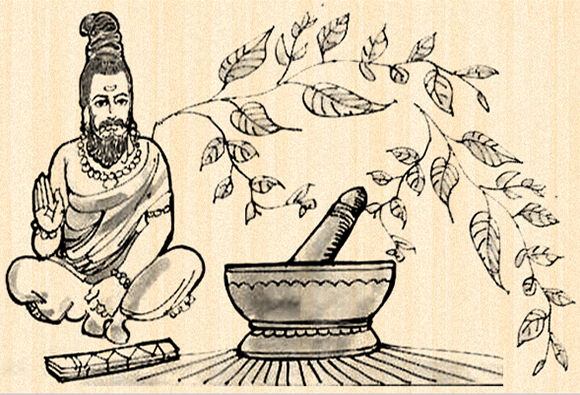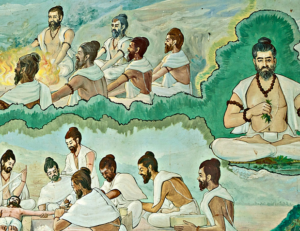
Ayurveda: The Ancient Indian Health Science

Ayurveda is considered by many scholars to be the oldest healing science. In Sanskrit, Ayurveda means “The Science of Life.” Ayurvedic knowledge originated in India more than 5,000 years ago and is often called the “Mother of All Healing.” It stems from the ancient Vedic culture and was taught for many thousands of years in an oral tradition from accomplished masters to their disciples. Some of this knowledge was set to print a few thousand years ago, but much of it is inaccessible. The principles of many of the natural healing systems now familiar in the West have their roots in Ayurveda, including Homeopathy and Polarity Therapy. It’s based on the belief that health and wellness depend on a delicate balance between the mind, body, and spirit. Its main goal is to promote good health, not fight disease. But treatments may be geared toward specific health problems.
What Is Ayurveda?
The name “Ayurveda” is derived from two words in Sanskrit, “ayuh” meaning “life” or “longevity” and “veda” meaning “science” or “sacred knowledge.” Ayurveda’s definition therefore roughly translates as “the science of longevity” or “the sacred knowledge of life.”
At its root, Ayurveda is a holistic tradition and way of living that can help each of us to claim and celebrate our capacity for wellness. Ayurveda can help us:
Sync up with our truest inner nature
Honor and develop our strengths
Hone in on our challenge areas
Redirect detrimental tendencies
Maintain balance in the face of adversity
In other words, Ayurveda is not simply about taking an herbal formula and waiting for the results. Instead, Ayurveda encourages you to be an active participant in your own journey toward healing.
This involves learning about your relationship with the elements and the unique combinations they create called doshas, which we will explore below. First, let’s take a look at Ayurveda’s background.
Ayurveda: A Brief History
The practice of Ayurveda as a medicine is believed to date back to over five thousand years, during the Vedic period of ancient India. The earliest known references to Ayurveda and its sister science, Yoga, appeared in scholarly texts from the time called “the Vedas.”
Ayurveda experienced a period of prosperity as the Vedic texts were taught and shared, but this was followed by an almost thousand-year struggle to remain relevant in the wake of India’s political struggles with various invading countries—most notably the British Empire.
Despite this, those who practiced Ayurveda on the fringes of society kept the tradition alive until India gained independence in 1947. Ayurveda then resurfaced as a major system of healthcare that endures in India to this day.
During the New Age movement of the 1980s, Ayurveda started to make its way westward, helped along by the expanding popularity of yoga and Eastern spiritualism.
Thanks in no small part to the teachings of respected physicians and herbalists like Drs. Vasant Lad, Deepak Chopra, and David Frawley, Ayurveda has gained notoriety among a growing population of health-conscious individuals in the United States and around the world.
Ayurveda’s Definition of Health
The Sanskrit word for health, svastha, is a state in which the mind, soul, and senses interact harmoniously to experience a feeling of Self, wellness, and even bliss. Achieving this may seem like a lofty goal, but Ayurveda provides a treasure chest of elegant and insightful tools to help us get there.
Ayurvedic Principles
Before you learn how Ayurveda can help you, you must first learn how to see yourself from an Ayurvedic perspective. The first step is to understand some key Ayurvedic principles, lenses through which Ayurveda views the universe.
These Ayurveda basics are foundational tools for:
Interpreting the laws of nature
Identifying various states of health or imbalance
Charting a course toward improved well-being
Examining these core principles will also help illustrate what makes Ayurveda such a timeless art and science.
The Five Elements
Ayurveda recognizes five elements as the fundamental building blocks of nature:
Earth
Water
Fire
Air
Ether (Space)
Every substance contains all five of these elements. That said, in a given substance, one or two elements are typically predominant over the others.
The Twenty Qualities
Ayurveda also identifies twenty qualities (gunas) that can be used to describe every substance or experience. These qualities are organized into the following ten pairs of opposites:
Heavy Light
Slow (Dull) Sharp (Penetrating)
Cold Hot
Oily Dry
Smooth Rough
Dense Liquid
Soft Hard
Stable Mobile
Gross Subtle
Cloudy (Sticky) Clear
The gunas are essential to understanding the Ayurvedic principle that like increases like and that opposites balance.
For example, a person who is particularly cold natured, living in a cold climate, in the middle of winter, is likely to be experiencing an aggravation of the cold quality.
The remedy? Heat—in the form of warming foods, hot drinks, heating spices, soothing baths, snuggly warm clothes, and if possible, an abundance of heart-warming experiences.
The Doshas and Your Ayurvedic Body Type
Then there are the three doshas (bodily humors): vata, pitta, and kapha. The doshas, or some combination of them, can be identified in various seasons, climates, landscapes, activities, plants, and animals.
Each of them embodies a combination of elements and qualities to create a functional entity—an energetic force of nature.
All three doshas are present in everyone, but the ratio between them varies a great deal from one person to the next.
We will get to that in a moment, but first, here is an overview of the essential nature of each dosha.
Each of us has a combination of these three doshas in our bodies at any given time. There is a combination of doshas we are born with, called our constitution, Ayurvedic body type, or prakriti in Sanskrit.
We also have a state of balance (vikriti) which represents the doshas that are elevated within our body at a given time. If the doshas accumulate beyond healthy limits (those determined by one’s constitution), they can wreak havoc on our health.
The Difference Between Constitutions and Imbalances
Knowing both your Ayurvedic constitution and your current state of balance is incredibly helpful. This knowledge will allow you to adjust the most basic components of your day—like how you exercise or when you eat—to better support your overall well-being.
However, there are key differences between the doshas that comprise your constitutional makeup and the doshas that can be imbalanced within you.
Understanding Constitutions
As mentioned before, your constitution, prakriti, or Ayurvedic body type, is established within you at conception and remains constant throughout your lifetime. It represents your natural state of equilibrium and your blueprint for perfect health.
Ayurveda recognizes seven basic constitutional types:
Vata-Type: A greater amount of vata, lesser amounts of pitta and kapha.
Pitta-Type: A greater amount of pitta, lesser amounts of vata and kapha.
Kapha-Type: A greater amount of kapha, lesser amounts of vata and pitta.
Vata-Pitta-Type (or Pitta-Vata): Greater amounts of both vata and pitta, a lesser amount of kapha.
Pitta-Kapha (or Kapha-Pitta): Greater amounts of both pitta and kapha, a lesser amount of vata.
Kapha-Vata (or Vata-Kapha): Greater amounts of both vata and kapha, a lesser amount of pitta.
Tridoshic (or Vata-Pitta-Kapha-Type): Equal amounts of all three doshas within the body.
Your constitution influences your physiology, your likes and dislikes, your tendencies and habits, your mental and emotional character, and your vulnerabilities toward imbalance and disease. Therefore, learning how to manage your constitution can be truly enlightening.
Understanding Imbalances
Discovering your current state of balance will show you the present level of the doshas in your system. In contrast to one’s constitution, the current state of balance can and does change over time as we move through different climates, different seasons, and the various stages of life.
A vata imbalance occurs when vata is in excess. This can cause fear, anxiety, physical and emotional constriction, ungroundedness, poor circulation, constipation, dry skin, cracking joints, emaciation, insomnia, twitches, tremors, and other abnormal movements.
A pitta imbalance occurs when pitta is in excess. This can cause anger, jealousy, inflammation, excessive heat, heartburn, loose stools, migraines, rashes, bruising, bleeding disorders, sharp hunger, an overactive metabolism, and difficulty sleeping.
A kapha imbalance occurs when kapha is in excess. This can cause attachment, greed, resistance to change, lack of motivation, heaviness in the mind and body, excessive sleep, depression, a sluggish metabolism, congestion, water retention, hardening of the arteries, and the formation of masses and tumors.
It is also possible for more than one dosha to be out of balance at a given time, or for all three doshas to be imbalanced.
As mentioned earlier, Ayurveda teaches that like increases like and that opposites balance. (See the twenty qualities table above.)
For example, let’s say your pitta is aggravated. You’ve had a short temper lately, are overly judgmental, and have some acidity in your digestive tract. Which qualities should you be interacting with to find balance?
Qualities that are hot, sharp, light, liquid, spreading, and oily.
Qualities that are cool, slow, heavy, dense, stable, and dry.
If you said “B,” you’re learning quickly! When we know which particular qualities are aggravated, we can be even more precise in our treatment strategies, finding specific practices to incorporate the necessary opposite qualities into our lives to find balance.
Which Dosha Should I Focus on Balancing?
Remember, if any of the doshas are out of balance (and for most of us, at least one of them is), your constitution will not tell you the entire story.
Your current state of balance may actually be more important because it highlights which doshas you need to pacify in order to return to balance, and it can help you identify the most effective treatment strategies for your particular situation.
There are, of course, some universals in Ayurveda: practices that are generally understood to be beneficial for all of us, regardless of constitution or current state of balance.
But if you follow only general principles, you may inadvertently limit Ayurveda’s extraordinary ability to specifically support you and your changing needs.
Benefits of Ayurvedic Medicine
The beauty of the Ayurvedic approach is that it is as elegant and intuitive to the novice as it is to the seasoned Ayurvedic practitioner. For those relatively new to Ayurveda, the tradition offers a clear path to improved wellness and vitality.
The same set of principles guides the skilled Ayurvedic practitioner in directing potent remedies to specific organs, tissues, and channels throughout the physical and energetic bodies.
At the heart of the Ayurvedic approach to wellness is the idea that like increases like and that opposites balance.
So whether we are attempting to mitigate the effects of certain innate vulnerabilities, or trying to correct an active imbalance, we can apply the energy of opposites in order to steer our bodies in the right direction.
The twenty qualities mentioned above provide the most straightforward illustration of how the concept works, and their grouping into ten pairs of opposites makes for a fairly intuitive grasp of how this wisdom can be applied in practical terms.
Beyond its traditional roots, there are many other reasons why you might be interested in exploring an Ayurvedic lifestyle. Now that you have familiarized yourself with some of the basic principles of Ayurveda, let’s explore some practical benefits Ayurveda has to offer.
8 Health Benefits of Ayurveda
Integrating Ayurveda into your life can be immensely beneficial to your overall sense of wellness, but what are some specific issues it can help with? Let’s explore eight distinct areas in which Ayurveda can improve your health:
1. Prevention
The traditional practice of Ayurveda is used to treat the cause as opposed to the symptom. It is therefore considered to be more preventative in nature than many other forms of medicine. Ayurveda can show you how to support your immune system and minimize the stress that often leads to imbalances and illness, getting to the root of the problem.
2. Daily Routine
Learning about Ayurveda can help you establish a dinacharya, or daily routine, to help you feel grounded, stable, and ready to start each day. Your daily routine might involve cleaning your tongue upon waking, practicing some yoga or meditation daily, and soothing your system periodically with a loving oil massage.
3. Ayurvedic Diet and Food Combining
Ayurveda has many diet and food combining suggestions to help maximize the agni, or digestive fire. Learning about your constitution and state of balance will help you determine which dietary choices are right for you.
4. Exercise: Ayurveda and Yoga
Certain asanas can have a cooling or heating effect on the body. Learning yoga poses from an Ayurvedic perspective is helpful for determining which poses would bring you optimal wellness.
5. Ayurvedic Herbal Support
Ayurveda has many insights into the world of herbal medicine. While we always encourage reaching out to a practitioner for additional guidance, discovering more about Ayurveda can help you learn more about Ayurvedic herbs, as well as which method of taking herbs is right for you.
6. Ayurveda for Energy and Vitality
Ayurveda’s approach to energy and vitality is multifaceted, with a special focus on adrenal health. By supporting your adrenals and finding natural sources of energy, you can stay active and doing what you love without experiencing a crash or depleting yourself afterward.
7. Ayurveda for Beauty
The Ayurvedic perspective on beauty focuses on the whole being, body, mind, and spirit. Ayurveda has tips for luscious hair, smooth skin, and more. Its holistic approach will leave you feeling beautiful from the inside out.
8. Ayurveda for Sleep
A surprising number of life’s challenges are caused by imbalanced sleep. Whether you need to sleep more or less, Ayurvedic methods can help improve your waking hours by helping you get to bed peacefully and consistently.
More About Hinduisme
Features
Copyright © 2018 SEAN-O-VISTA

Powered with 





